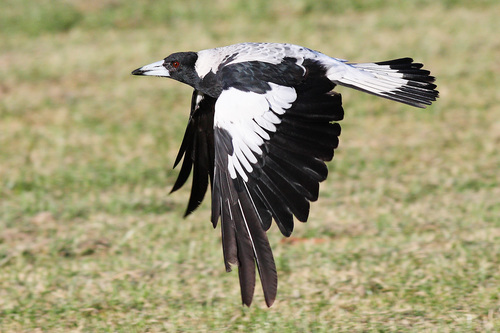
Australian Magpie
The Australian Magpie (*Gymnorhina tibicen*) is a ubiquitous and iconic bird across much of Australia. Known for its striking black and white plumage, complex vocalizations, and occasionally assertive behavior during breeding season, it plays a significant role in the Australian ecosystem. It is an adaptable species, found in a variety of habitats, and is well-known for its intelligence and complex social structures. Culturally, the magpie is featured in Aboriginal folklore and is a popular, if sometimes controversial, symbol of suburban Australia.
37-43 cm
Length
65-85 cm
Wingspan
Least Concern
Conservation Status
Distribution
Found throughout most of Australia, excluding some of the most arid interior regions and the densest rainforests. Introduced populations exist in New Zealand and some Pacific Islands. It shows limited migratory behavior, with some populations undertaking local movements in response to food availability or breeding requirements.
Lifespan
Up to 25 years in the wild, and potentially longer in captivity.
Australian Magpie's Habitat
Habitat Types
Open woodlands, Grasslands, Agricultural areas, Urban parks and gardens, Suburban areas
Climate Zones
Temperate, Subtropical, Mediterranean, Arid
Adaptations
Highly adaptable to a wide range of environments, exhibiting behavioral flexibility in foraging and nesting strategies. Its ability to thrive in human-modified landscapes is a key adaptation.
Variations
Several subspecies are recognized, differing primarily in the pattern of black and white on their back and nape. These include the black-backed magpie (*G. t. tibicen*), the white-backed magpie (*G. t. hypoleuca*), and others.
Appearance
Breeding Plumage
Plumage remains largely consistent throughout the year.
Seasonal Feather Changes
No significant seasonal variations.
Sex Based Plumage Differences
Males generally have purer white areas, whereas females may have a greyish tinge to the white, particularly on the nape.
Notable Features
Striking black and white plumage., Powerful, slightly hooked bill., Reddish-brown eyes.
Diet and Feeding
Primary Foods
Invertebrates (insects, spiders, worms), Small vertebrates (lizards, frogs, mice), Carrion, Seeds, Fruits
Foraging Behavior
Primarily ground foragers, walking and probing the soil for invertebrates. They are opportunistic feeders and will also take food scraps in urban areas.
Specializations
Strong bill adapted for probing and digging. They are also known to cache food, hiding it for later consumption.
Seasonal Diet Variations
Diet may shift slightly depending on the availability of food, with a greater reliance on seeds and fruits during leaner periods.
Behavior
Social Structure
Live in territorial family groups, which can range from a single pair to larger groups of up to 20 individuals. These groups cooperatively defend their territory.
Communication
Complex and varied vocalizations, including carolling songs., Warbling calls., Territorial displays., Visual signals (e.g., postures)
Migration
Generally non-migratory, although some local movements may occur in response to resource availability.
Territorial or Group Behaviors
Highly territorial, defending their area year-round. During breeding season, they are particularly aggressive towards perceived threats, including humans and other animals, and will swoop to deter them.
Conservation
Threats
Habitat loss (though they are adaptable), Vehicle collisions, Pesticide exposure, Persecution by humans (due to swooping behavior)
Protection Programs
General wildlife protection laws.
Local National Laws
Protected under wildlife legislation in all Australian states and territories.
Population Trend
Stable
Population Estimates
Widespread and abundant; exact population numbers are difficult to determine, but it is considered a common species.
Interesting Facts
Australian Magpies are known for their exceptional mimicry skills.
They can imitate the calls of other birds, as well as human sounds and even dog barks.
They can recognize individual human faces.
Research has shown that magpies can remember and distinguish between different people, and may target specific individuals they perceive as threats.
Magpie groups engage in complex social behaviors, including cooperative breeding and play.
Young birds often remain with their parents for several years, helping to raise subsequent broods.
Faqs about Australian Magpie
Why do Australian Magpies swoop?
Swooping is a defensive behavior exhibited during the breeding season to protect their nests and young from perceived threats. Only a small percentage of magpies swoop, and it is usually the males that are responsible.
How can I avoid being swooped by a magpie?
Avoid known nesting areas during the breeding season. If you must enter a nesting area, wear a hat and sunglasses, or carry an open umbrella. Walking quickly and calmly, rather than running, may also help.
Are Australian Magpies related to European Magpies?
Although they share a similar name and some superficial resemblance, Australian Magpies are not closely related to European Magpies (which are corvids). They belong to the family Artamidae.
Copyright @ Nature Style Limited. All Rights Reserved.
 English
English